If you’re on the brink of adopting a Labrador, it’s important to familiarize yourself with a comprehensive Labrador puppy training schedule. This schedule is a cornerstone of their upbringing and covers essential training routines.
A Labrador puppy training schedule is most effective when initiated at two months old. Begin by establishing yourself as the pack leader to create a foundation of respect and understanding. Progressively, introduce 2-4 commands each month, starting with simple cues triggered by gestures.
As your puppy grows and learns, gradually shift to more complex commands that are triggered by verbal cues. This structured approach ensures a balanced and comprehensive training regimen tailored to the developmental stages of your Labrador puppy.
Knowing the right training schedule is essential in ensuring your Lab puppy grows into a well-behaved and happy adult dog.
In this guide, we’ll delve into the key aspects of a Labrador puppy’s training schedule, month-by-month, providing you with the tools and knowledge needed for a successful and rewarding training experience. You will know exactly what to teach and when.
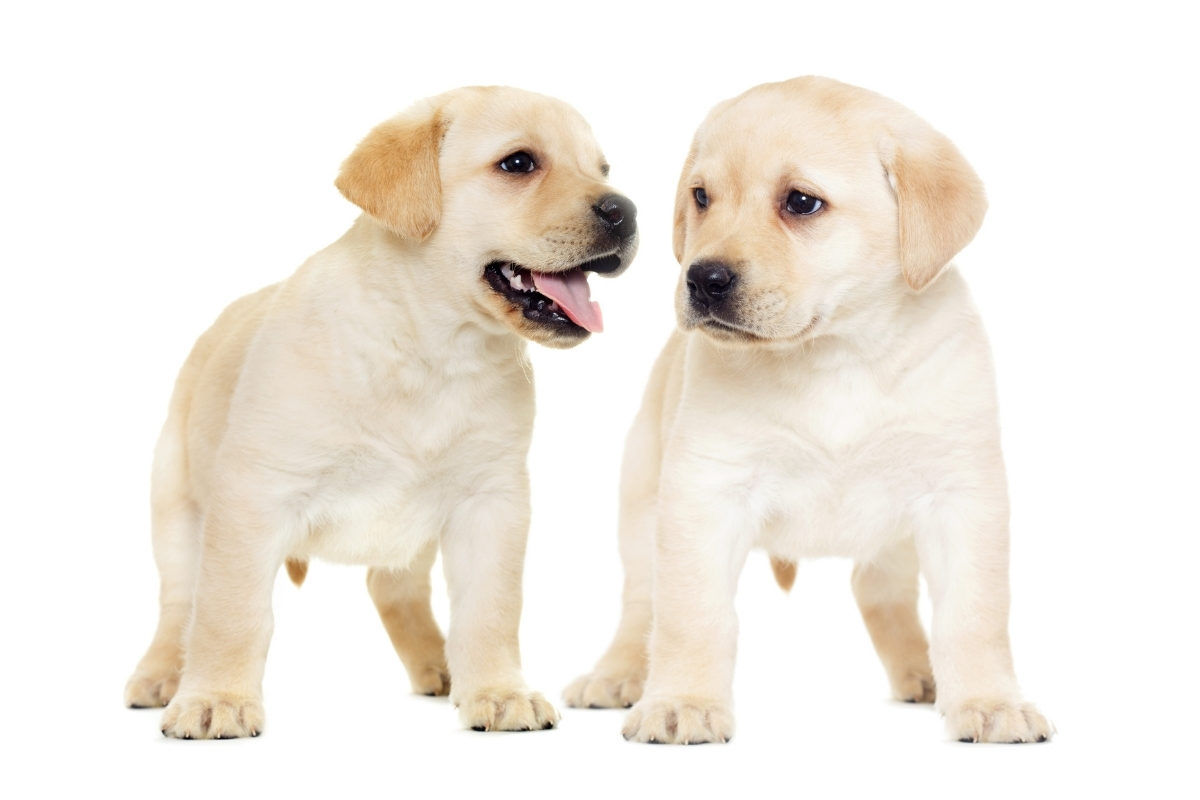
Are Labrador Puppies Easy to Train?
Labradors are often adopted at eight weeks but are far from fully grown, socialized, or trained. If you’ve recently adopted a pup, you may find dog training quite daunting and, more importantly, be wondering how easy or difficult Labs are to train.
Labrador puppies are easy to train because of their high social intelligence, loyalty, and desire to please; they can understand commands and positive consequences in the first few weeks.
However, if you do not teach them early on, you may need to work harder to get them to unlearn bad habits.
However, please note that I assume you’ve adopted the puppy at a young age and started training at the right time. However, don’t worry if you’re a bit late to the party or bring home an older puppy or a rescue dog; only realize it may take your Labrador a little longer to be obedience trained.
Ideal Age To Train a Labrador
Since it becomes harder to train your dog the older he gets, one might assume that it would be best to train a Lab while he is a few weeks old. However, there’s such a thing as being too early in training your pup.
You should train your Labrador at two months old because, by that stage, he has grown enough to take cues and is sufficiently self-reliant not to need his mother to survive. He will have already learned canine behaviors by interacting with his mother and littermates, but now he can continue to learn by association.
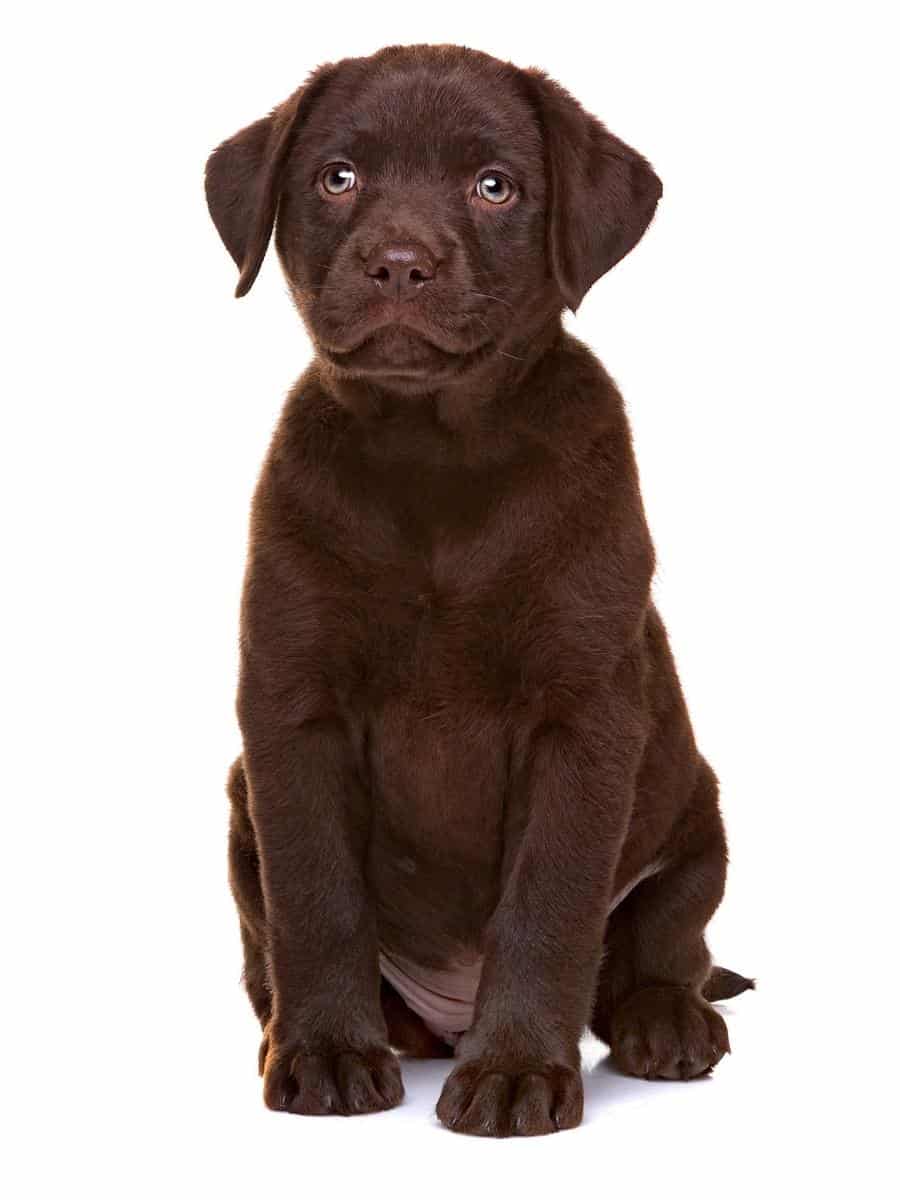
It’s better to err on the side of being later than eight weeks than the opposite when starting puppy training. You can be up to two weeks later than the eight-week mark and get your pet appropriately trained.
Still, if you’re two weeks early, you may confuse or frighten him by overloading him with stimuli before he’s ready to make the correct associations. A traumatic experience can have a negative and counter-productive effect during this period.
Read further if you:
- Have a Labrador older than seven weeks (or plan to get a Lab puppy)
- Want an approximate schedule for training your pup
- Wish to train a dog using positive reinforcement and ethical training methods
- Want to commit to 1.5 years of casual dog training
| Age of Puppy | Labrador Puppy Training Schedule: What to Teach |
|---|---|
| 2 Months | Set Initial Anchors Establish Authority Early Socialization Potty Training Bite Inhibition Instill Patience |
| 3 Months | “Sit,” “Down,” and “Stand” Heel Recall Increase Socialization Target Training |
| 4 Months | Sit and Stay Fetch Continue Potty Training Leash Walking |
| 5 Months | Reinforce Previous Training Contain Energy |
| 6 Months | Increase Exercise Start Advanced Command Training, e.g., “Leave it” and “Wait” Complete Potty Training |
| 7 Months | “Take it” “Speak” |
| 8 Months | Recognizing Commands for Different Places “Quiet” |
| 9 -18 Months | “Spin” “Roll Over” “Go Ahead” Other Tricks, e.g., “Crawl” and “Wave” |
Training Your 2-Month-Old Labrador Puppy
As mentioned above, the best time to train your Labrador puppy is at eight weeks old. At this point, the puppy is still learning your role in his life, and you can’t take a position of authority over him for granted.
Moreover, the puppy can only form the most obvious associations between command, response, and consequence, so it is crucial to adapt your training strategy accordingly.
Set Initial Anchors
When training a 2-month-old Labrador puppy, you should wait till he’s doing something right and then produce a stimulus that he can naturally link to the wanted activity. For example, you can start clapping if the pup is running toward you.
Once he realizes that clapping and running toward you are linked, you can clap, and he will run toward you. However, you can’t expect the latter to happen at this stage. For now, notice the following and set distinct anchors for each.
- Following you
- Eating food / consuming a treat
- Assuming a natural heel position (likely if there’s another dog in the house)
Clapping, whistling, and a specific word verbalized in a particular tone can all be good anchors.
For now, you should avoid using anchors that are too similar. “SIT” and “RUN” might sound different for a grown Labrador, but a young puppy might classify both as “mouth sounds.” That’s why the above anchor suggestions are distinct.
Establish Authority
You must establish yourself as his guide at an early phase in your dog’s training. This melts away a lot of the resistance as you train your pup to understand and respond to more complex commands.
Therefore, the first step should be encouraging your Labrador to follow you. As you may know, dogs evolved from wolves, and wolves follow the pack leader (usually a parent).
Of course, when training a 2-month-old Labrador puppy, you have to incentivize him to follow you around.
With older dogs, you can get away with delaying gratification for a longer period, but initially, you will have to praise, cuddle, or reward the puppy with training treats.
It would be best if you did not take abrupt turns in the first week of your puppy’s training. You need to build a positive reinforcement loop and let your dog establish a connection between following you and receiving a pleasant experience.
Once your puppy seems motivated to follow you for the incentive, you can start making sudden turns and train him to follow you, despite the direction changes.
Lower Socializing Barriers
Labradors might be predisposed to being more social, but they can still develop uncharacteristic introversion if they aren’t exposed to enough people or situations early on in their lives. You should take your puppy outdoors and let him exercise his socialization potential at a young age.
Visiting friends and family is one way to go about it. You can also spot a dog park and carry him there. Remember that your pet is still learning to follow directions and walk with you. You cannot expect him to cover long distances.
While Labrador pups aren’t at a higher risk of getting agoraphobic, they can develop an unhealthy attachment to the indoors in rare cases.
The best way to avoid this is to take them far enough from the house and ensure they have a positive outside experience. It is worth noting that you should do this as often as you can, preferably daily.
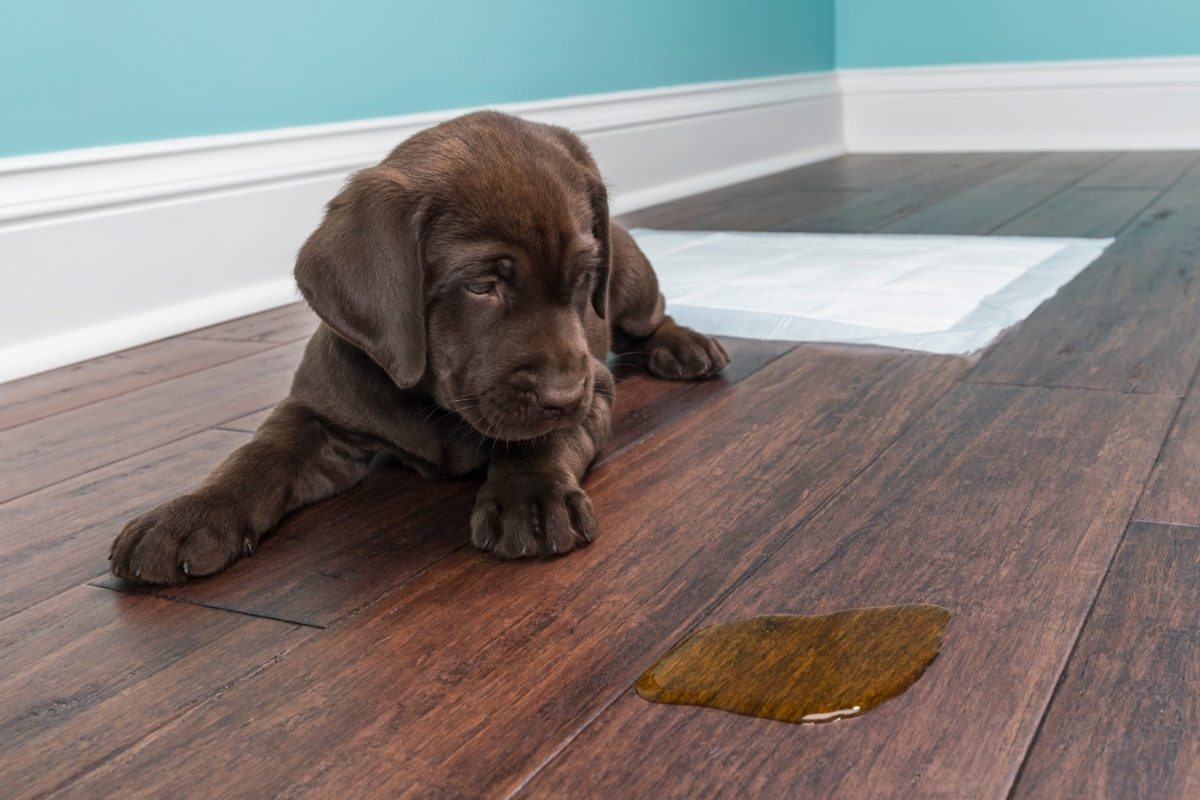
Start Potty Training
It would be best to start potty training your Lab puppy the first day you bring him home. Start by showing your pup where you want him to potty, such as a sectioned-off area of your yard or garden.
Make the area you want your pup to toilet in look different from the rest of your yard so he’ll learn to recognize it. A good idea is to cordon off a small area and add some bark chippings.
Next, you need a potty training schedule, such as first thing in the morning, after mealtimes and play, and hourly for young pups.
Many owners use dog crates to help with house training. I have a step-by-step guide on Labrador puppy crate training where you can learn tons more.
Discourage Biting
If you follow my blog, you know I am against punishment-oriented training. If you train your dog young enough to avoid harsh bites, you will not need punishment-driven discipline strategies.
In any case, using physical force or yelling at your pup will only instill fear and distrust and can cause aggression in your dog.
You can also check out my article, How to Discipline a Labrador, for greater insight into this topic.
When teaching a 2-month-old Lab pup, you can put him in a timeout if he bites with enough force, but he’s less likely to understand what he has done wrong!
Instead, you can wait until your Labrador bites during a positive activity and then discontinue it. It will anchor the consequence better.
For example, if you’re giving your Labrador puppy a treat and he snatches the first treat violently, you can withhold the second treat until he learns to take it from your hand gently. But in contrast, if he bites you while you’re reading your book, there’s little you can do regarding productive punishment.
You can act hurt and convey that your dog’s actions have affected you. To do this, let out a high-pitched yelp such as “OUCH!” and then redirect the biting by offering a chew toy.
Follow up using positive reinforcement by rewarding the correct behavior with a treat. Your Labrador will quickly learn that displaying good behavior reaps nice things.
Puppies need to learn their bite inhibition (soft-mouth) by continuing the excellent work their mother and siblings taught them.
Don’t worry; Labradors learn this skill pretty quickly as they were bred to retrieve downed game birds with a soft mouth and not damage them while retrieving them for their hunter.
Here’s an Excellent Video all About Puppy Biting and Bite Inhibition Training…
Instill Patience
You must use your best judgment when training your dog to be patient. Generally speaking, your Labrador will be mature enough to learn self-control by the tenth week.
You can learn more about how to train an 8-week-old Labrador Puppy in my beginner’s guide.
What to Train a 3-Month-Old Lab Puppy
Assuming you’ve trained your puppy well from the eighth week to the eleventh, you’re ready to elevate his training. For the next few weeks, you’ll teach your Labrador how to respond to commands and position yourself as a companion.
Teach the Heel Position
While your 3-month-old Labrador puppy will initially follow you, if you adjust your pace, you’ll soon have him walking alongside you at the heel position, on your left-hand side, without a leash, harness, or fear of punishment.
You can use a clicker or a whistle to teach your puppy to assume the natural heel position.
Chances are, at first, your Labrador will try to change his pace to be behind you because of the force of habit. Walking in areas familiar to your dog will eliminate this problem. That’s why it is essential to take him to many different places in the earlier weeks, constantly working on socialization.
Train Your Dog to Assume Positions on Command – Sit, Down, Stand
Your 3-month-old Labrador Puppy is mature enough to learn how to sit, stand, or hold a down position. While you previously trained him to assume a heel position, you can also teach him these techniques.
You may notice that your puppy can tell your words apart by the thirteenth week. So by the time he is four months old, you can use the position cues and positive reinforcement to get your dog to follow.
Activate Anchors – Start Recall Training
In weeks 8-11, you established anchors for some of your dog’s positive behaviors. These included whistling, clapping, or saying a specific word to indicate that your Labrador is doing well, typically followed by a well-deserved treat.
Now is the time to see whether the anchors work!
Where you previously whistled when your Lab ran towards you, now you must whistle, so he begins his run.
You are training your 3-month-old Labrador puppy to associate the whistle sound with your command for him to run toward you. This is the start of his Labrador recall training.
If this doesn’t work at first, there’s no need to be disheartened. Teaching good recall is an ongoing process.
My dog was around 12 months old before seeing a noticeable improvement in her recall. Please avoid forcing the dog, as that only introduces confusion.
If you discover that your Labrador isn’t responsive when you activate the triggers, you should continue re-establishing the anchors and try again after another week.
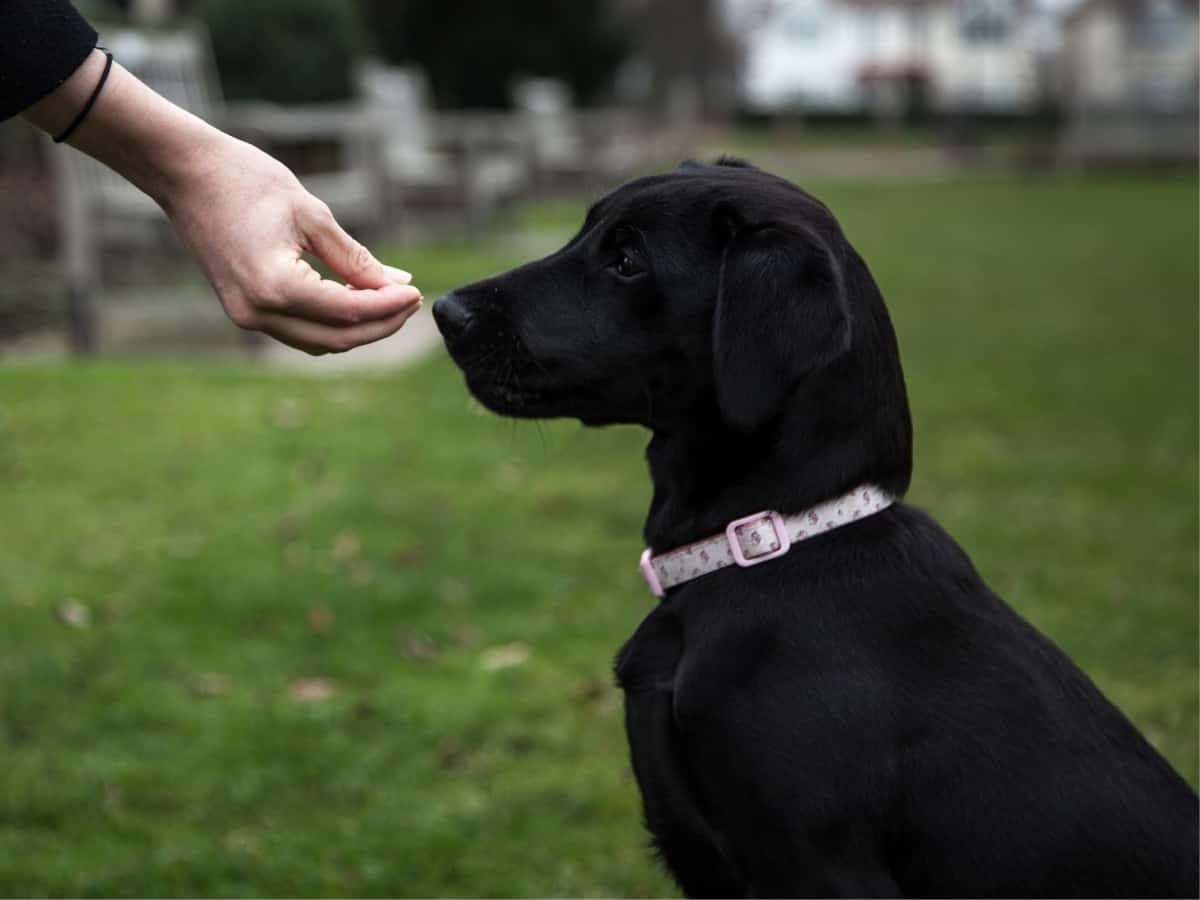
Build Comfort With Crowds – Work on Socialization
You have trained your Labrador to acknowledge close friends and family in the past few weeks. While this enables the puppy to be more social when you have visitors, a grown dog must learn to walk outdoors without acting out.
That’s why you must start taking your dog to slightly more crowded locations and experience many different stimuli at this stage. This transition must be gradual, and try to keep experiences positive.
Teach Your Lab Target Training
Teach your Lab to ask for treats! Here, I use the word ‘treats’ loosely. Whether it is a cuddle, a pat, attention, or something tasty, you must teach your pup target training, for example, to touch a target with a specific part of his body.
Remember that your Lab may end up biting or clawing to communicate if you do not teach him more acceptable communication methods.
Here, I recommend teaching your Labrador to touch your hand with his nose. While you’ll actively encourage him by holding out your hand, he will soon learn to softly connect your hand with his nose when you’re sitting.
Ultimately, this is an excellent replacement for bites! Hand targeting is fun to teach, helps your pup build trust, and gets him using his brain!
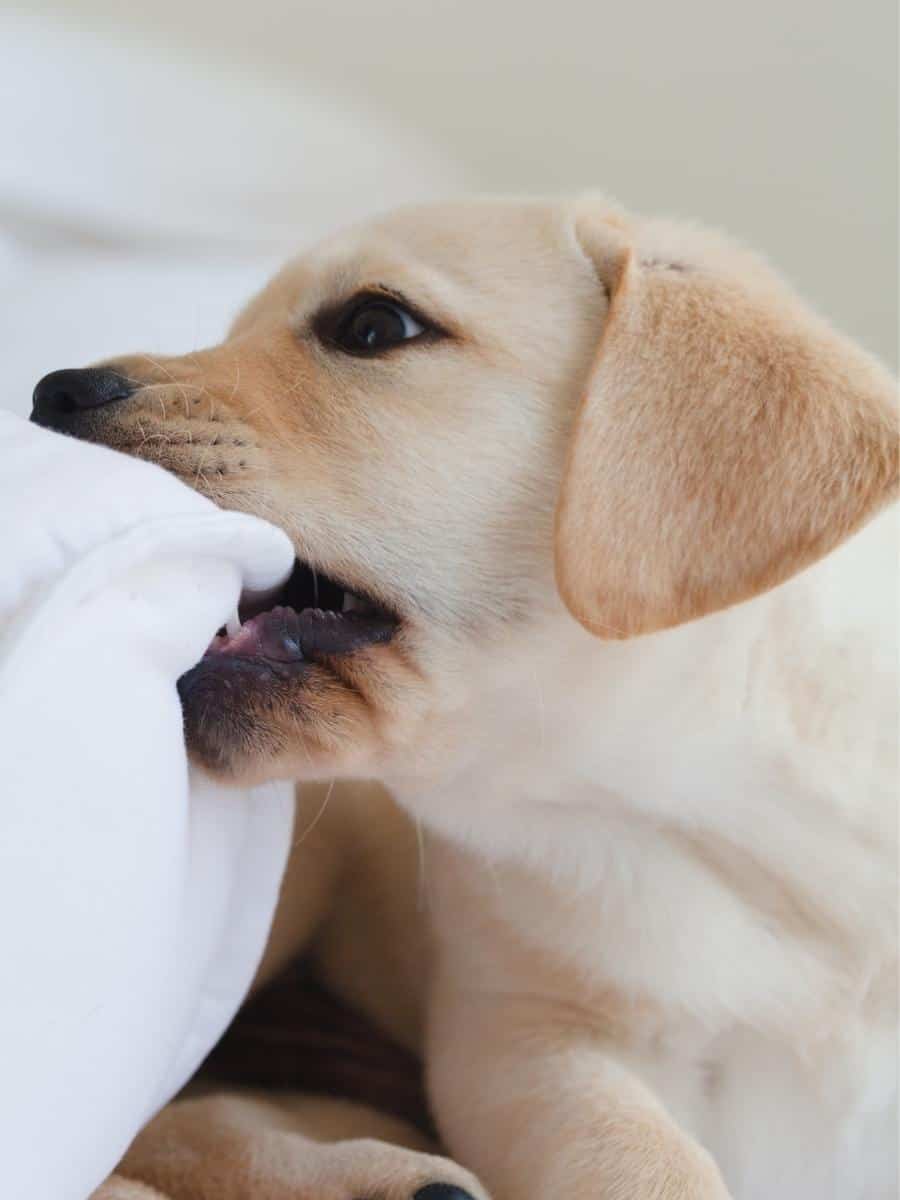
Time to Train Your 4-Month-Old Lab
Crossing the fifteen-week threshold means your Labrador is ready for some ‘big boy’ training. You have laid a strong foundation of discipline and positive reinforcement, making it easier to train your dog to follow more complex commands.
In these weeks, you will introduce him to assuming different positions, obeying your commands as he moves away from you, and reacting to more nuanced anchors.
Remember, 4-month-old Labrador puppies have a short attention span, so avoid long training sessions.
Teach the Sit and Stay
Teaching your Lab to sit and stay is a useful command for him to learn. He’s already learned to sit for a reward, but you can now progress this by training him to stay, keeping his eyes focused on you at all times.
Don’t expect too much too soon, as this can be difficult for your pup to grasp initially. Start by getting him to hold his “SIT” for a few seconds and gradually increase.
Check Out This Cool Video of a Gorgeous Labrador Learning to Sit and Stay…
Train Your Dog to Fetch
If you have taken your Labrador to public parks and he has seen other dogs play fetch, it will be easier to teach him to retrieve whatever you throw.
You can take one of your dog’s favorite toys and throw it at a short enough distance. Your Labrador may not return the toy to you for a second round, but he will soon get the idea of retrieving it.
You can gradually turn it into a game of fetch over the next few weeks and reward your doggo with high-value training treats. Don’t forget; your Labrador has it in his genes to master “FETCH!” in no time!
Continue Potty Training
In the fourth month of Labrador training, you will continue potty training with a degree of independence. Teach your dog not to make a mess by rewarding him every time he doesn’t make one! Continue with a good schedule and sync your walks with his natural cycle to align with the times he needs to go.
Teach Your Lab to Walk on the Leash
Walking outdoors on a leash is an integral part of dog training. You can use it to control your Labrador and later to test his ability to execute a command off-leash. A harness is also a good idea and is used for outdoor training and walks.
5-Month-Old Labrador Puppy Training
A five-month-old Labrador puppy is ready to be tested for his general obedience and the ability to deal with distractions, whether other dogs, people, or other animals such as squirrels or birds.
A simplification of previous months’ training would be that you have sufficiently socialized your dog and trained him to recognize and associate personal affection, attention, toys, walks, and food as rewards.
Reinforce Previous Training
Now is the time to use the above as a reward and reinforce previous training while introducing distractions and prolonging your dog’s wait before gratification.
Earlier, I mentioned that you could not expect an eight-week-old puppy to delay gratification. Your puppy can deal with distractions at five months old if you introduce them slowly.
Contain His Energy
At five months, your Labrador’s physical energy finally catches up with his enthusiasm and curiosity. You must be prepared for your dog to run ahead of you now!
However, suppose you have developed a solid relationship with your pup and worked on his training. In that case, he will stay within a reasonable distance, remaining by your side and showing loyalty.
Training a 6-Month-Old Pup Into the Teenage Years
This is the last month to call your puppy a puppy as he moves into his “teenage years!” He is now officially an adolescent. Once your Lab puppy has reached his 6-month milestone, it also marks the point where you introduce him to advanced obedience training.
The good news is that all the training you have previously given will make it easier for your dog to follow your lead.
Conclude Potty Training
Your dog has had months to learn how to communicate his need to go potty. He has also likely refined the patience to hold it instead of relieving himself on the floor.
Therefore, you can communicate your disappointment with your body language if your dog makes a mess. Avoid physical punishment and verbal chastising, as it impacts your dog negatively.
All dogs can still have the odd accident up to 12 months old. Moreover, you must be prepared for your dog to relieve himself indoors if he is excited or frightened, known as excitement or submissive urination.
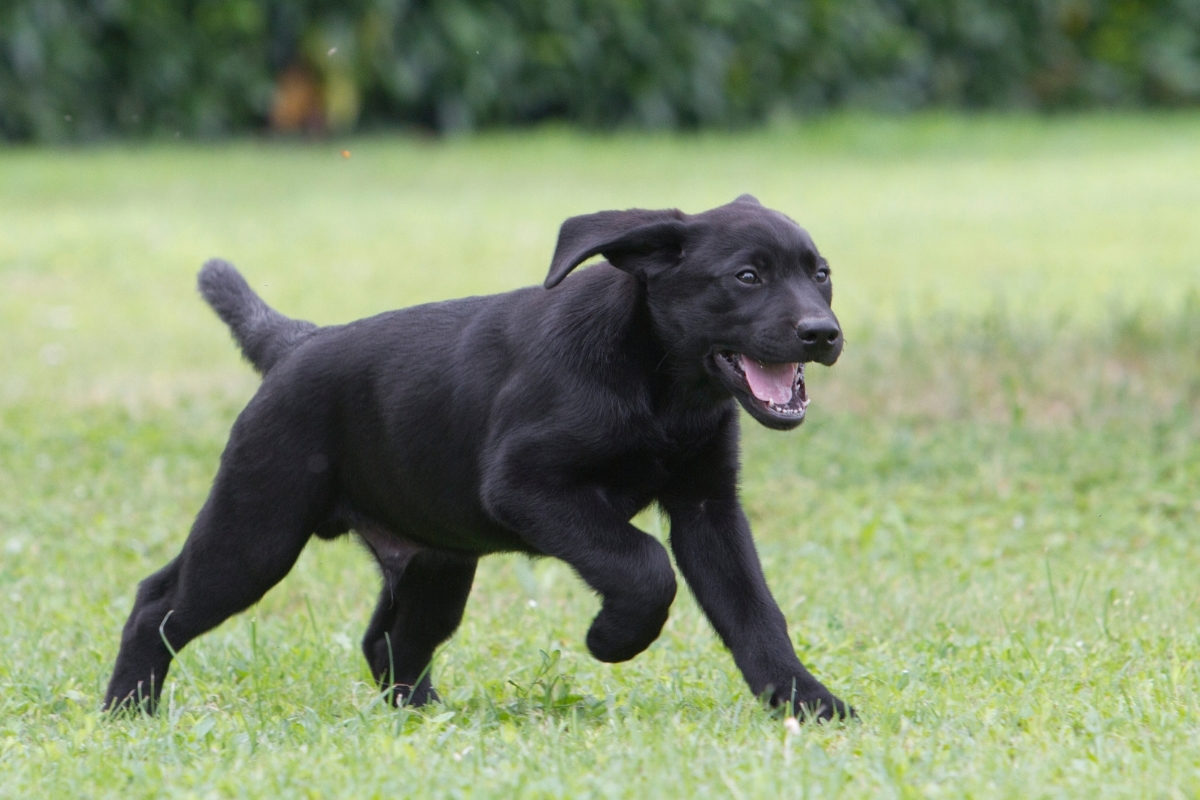
Increase Exercise
Now that your Lab puppy is six months old, you can increase his exercise to thirty minutes twice daily. Energy levels, especially for larger breed dogs, escalate during this time.
While the average exercise for a pup before this is generally five minutes of exercise per month of age, twice a day, a six-month-old Labrador can be out for one hour if you split his walks into thirty minutes a day.
Advanced Command Training
This is also the time to focus on your dog’s advanced training. To train your 6-month-old Lab puppy, start with two commands with the most practical use. “LEAVE IT!” is the command that instructs your dog to stop holding onto whatever he is biting down on.
This is useful when he grabs hold of something he shouldn’t and is a powerful way to instill discipline.
The second command you need to train your dog is the “WAIT!” command. As mentioned earlier, you’ll exercise your Labrador a lot more from now on. If your pet runs far ahead, the “WAIT” command can help you catch up!
From six months onwards, until your Labrador is a well-trained adult, you can teach the following commands or tricks in any order.
Training Your 7-Month-Old Puppy
As your Lab progresses to seven months old, a lot of the previous training needs to be kept consistent as you gradually teach him to comprehend more commands.
I recommend adding up to two cues to your Lab’s training every month, or if he struggles to grasp a particular technique, continue working at that particular one until he has mastered it.
“TAKE IT!”
You can train your 7-month Labrador to take things from your hand, following any appropriate command. While most people resort to “TAKE IT!” you may want to use different words so your dog isn’t confused when you use “take it” in everyday conversation.
“SPEAK!”
You command your Labrador to bark or be vocal. Maybe there is a trespasser, and you want your dog to scare them away. This is great to teach your Lab, as they don’t make good guard dogs due to their friendliness!
Training an 8-Month-Old Lab
Your 8-month-old Labrador is ready to learn even more commands. You will need to continue training your dog to hold things or release them on command, but you can also proceed to add distance and even more background distractions.
“QUIET!”
You can train your dog to stop barking on command. Ironically, you must teach him to bark on command before learning to be silent on cue.
Continue using the word “SPEAK!” as a trigger and do something that leads him to bark naturally. You will strengthen the association between the word “speak” and your dog’s barking by giving him a treat.
Once your dog stops barking, say the word “QUIET!” Reward him with a treat and give lots of praise at the precise moment that he stops barking.
Over this month, he will learn to associate the respective commands with barking and silence. This is tricky, but your Lab will eventually get there if you practice and stay consistent.
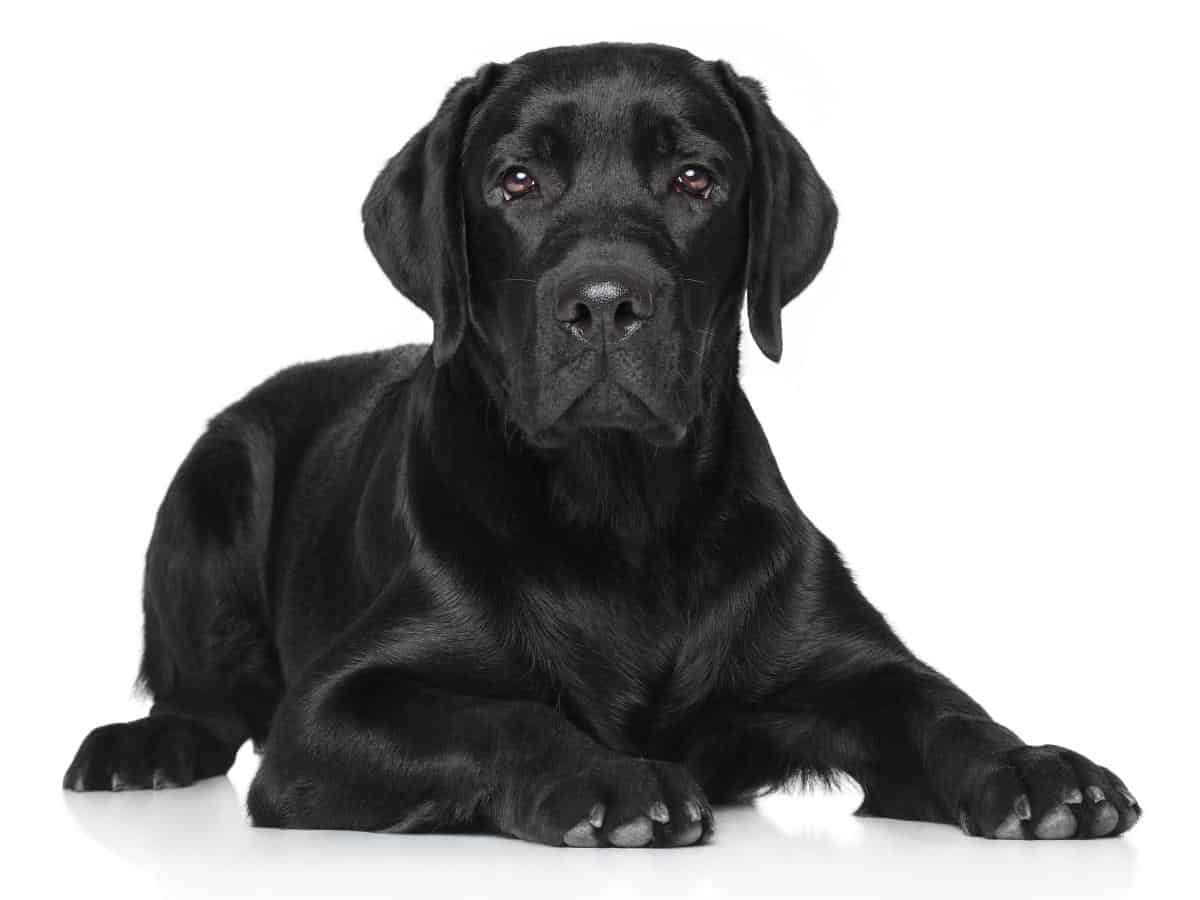
Different Commands for Different Places
Usually, “BED!” is the ideal command to teach a dog to go to his bed or crate on cue. The eighth month is ideal for training your Lab to go to different places upon hearing the command word.
This could be for practical reasons or to fully use your dog’s intelligence. Either way, do not overload him with place commands, and stick to no more than two per month.
Tricks to Train a 9-Month-Old Labrador
If you find the training you’ve conducted over the last month beneficial, you can easily continue adding more places to your dog’s comprehension. Or you can use the ninth month to teach a cool party trick!
Teach Your Lab to Spin
By dangling a treat in front of your Labrador and moving it in a circle till he’s spinning, you prime him for a command anchor. You associate the reward with this anchor by saying “SPIN!” and giving a treat.
After a week, you can remove the treat and teach your Lab to follow your finger. Of course, you will still need to reward him after he follows the command. By the third week, you can cue your doggo to spin and see if he does so without your finger guiding him in a circular motion.
It might take an extra week or two, but I recommend this as an addition in the ninth month because it allows you to continue training your pet to learn previous commands better. You can teach him to go to different places, hold or release objects, and fetch toys.
10-Month-Old Labrador Training
Even in the tenth month of your Labrador’s training, you must constantly reinforce previous commands. That’s why I recommend adding only a simple “ROLL-OVER!” trick to his repertoire in the following four weeks.
Your Lab has mastered the “DOWN!” position at 3 months old. You can now progress this further and teach him to roll over on command. Like teaching “SPIN,” use high-value treats with tons of praise.
How to Train an 11-Month-Old Pup
This is the last month before your Lab’s first birthday! Use this time to teach your 11-month-old Labrador, “GO AHEAD!” You direct your dog to stay ahead of you, the opposite of “WAIT!” This is also used in agility competitions to command your dog to go ahead of you.
Training at the 1-Year Milestone
While the one-year milestone might seem significant from a human’s perspective, your dog’s capability to internalize commands and learn to follow cues doesn’t change drastically past this threshold. Your 1-year-old Labrador only learns to comprehend more at the same pace as he has since the 6-month mark.
Read more: 7 Easy Ways To Train a 1-Year-Old Labrador
What does change is the fact that your dog is going to interact with other people more often. To keep him from simply barking for others’ attention, you can train him to do more tricks to give him a more attractive presence. “CRAWL!” and “WAVE!” commands are perfect for this period.
You should also audit previously taught commands and see any weak associations you can reinforce.
18-Month-Old Labrador Training
You will not have to alter your training regimen dramatically if you have trained your Labrador properly from eight weeks onward. If anything, this is the period where you customize his training to your convenience.
Up to this point, you have learned patience, altered your routine, and even made friends to accommodate your pet’s growth and education.
Now is when your dog must learn to be compatible with your life. From the 18-month mark onwards, you must train your dog to be harmonious with modern adult life (within reason).
It is sad to see dog owners having to give away their pets because of behavior issues. Such things are avoidable if you train your dog correctly and sufficiently exercise him.
Related: Labrador Behavior Problems: Tips That Actually Work!
It is also possible you’ve come across this article having adopted an older dog. If you have an 18-month-old Labrador who doesn’t seem to have previous training, do not panic!
Establish authority by having a positive yet commanding presence. Once your dog acknowledges your authority and sees you as a guide, you can treat him as a six-month-old, albeit on an accelerated schedule, and train him accordingly.
Check out my guide on command training for tons more info, The Ultimate Labrador Training Commands Guide.
FAQs
How long should each training session be for a Labrador puppy?
For your young Labrador puppy, keep training sessions short – no more than 10-15 minutes is best for their attention span. Listen for signs of losing focus, like squirming. End on a positive note while they still want to learn.
With time and maturity, your Lab’s attention will grow, allowing for longer, more productive lessons.
What treats should I use for positive reinforcement during training?
When training your Labrador puppy, small, soft treats work best for quick rewards and maintaining your pup’s focus. Look for training treats with meat or cheese as the primary ingredient. Cut them into small pieces so your pup gets frequent rewards.
Praise and petting can also positively reinforce your puppy’s good behavior.
Let’s Wrap This Up!
Labradors are an intelligent breed and are thus highly trainable. Your job becomes even easier once you have a workable training schedule and stick to your routine.
This month-by-month Labrador puppy training schedule will help you successfully train your dog and turn him into the beloved companion you always desired. Good luck with your training!





